Yunhao Liu
QUIDS: Quality-informed Incentive-driven Multi-agent Dispatching System for Mobile Crowdsensing
Dec 18, 2025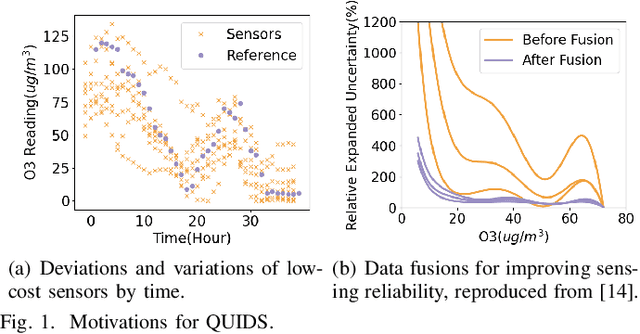
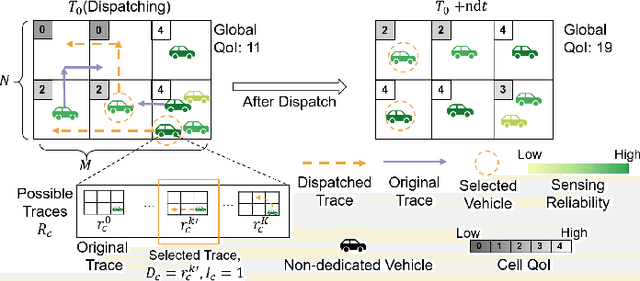
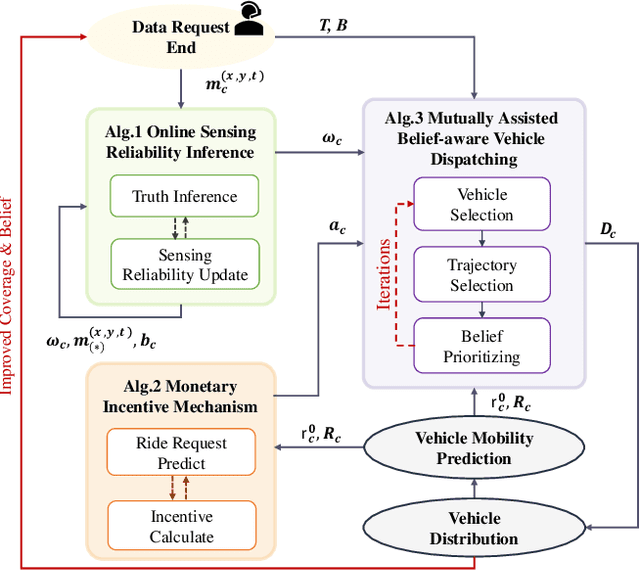
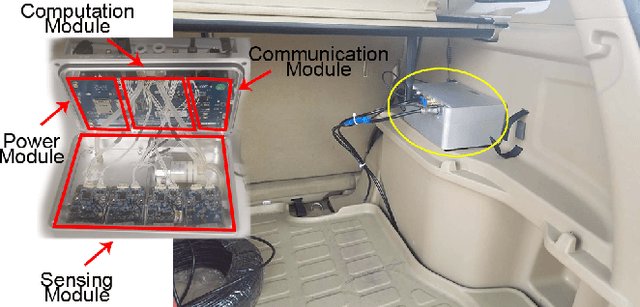
Abstract:This paper addresses the challenge of achieving optimal Quality of Information (QoI) in non-dedicated vehicular mobile crowdsensing (NVMCS) systems. The key obstacles are the interrelated issues of sensing coverage, sensing reliability, and the dynamic participation of vehicles. To tackle these, we propose QUIDS, a QUality-informed Incentive-driven multi-agent Dispatching System, which ensures high sensing coverage and reliability under budget constraints. QUIDS introduces a novel metric, Aggregated Sensing Quality (ASQ), to quantitatively capture QoI by integrating both coverage and reliability. We also develop a Mutually Assisted Belief-aware Vehicle Dispatching algorithm that estimates sensing reliability and allocates incentives under uncertainty, further improving ASQ. Evaluation using real-world data from a metropolitan NVMCS deployment shows QUIDS improves ASQ by 38% over non-dispatching scenarios and by 10% over state-of-the-art methods. It also reduces reconstruction map errors by 39-74% across algorithms. By jointly optimizing coverage and reliability via a quality-informed incentive mechanism, QUIDS enables low-cost, high-quality urban monitoring without dedicated infrastructure, applicable to smart-city scenarios like traffic and environmental sensing.
Stealth Fine-Tuning: Efficiently Breaking Alignment in RVLMs Using Self-Generated CoT
Nov 18, 2025Abstract:Reasoning-augmented Vision-Language Models (RVLMs) rely on safety alignment to prevent harmful behavior, yet their exposed chain-of-thought (CoT) traces introduce new attack surfaces. In this work, we find that the safety alignment of RVLMs can be easily break through a novel attack method termed \textbf{Stealth Fine-Tuning}. Our method elicits harmful reasoning traces through \textbf{segment-level interference} and reuses the self-generated outputs as supervised fine-tuning data. Through a \textbf{turn-based weighted} loss design, yielding a lightweight, distribution-consistent finetuning method. In our experiment, with only 499 samples and under 3 hours on a single A100 (QLoRA), Stealth Fine-Tuning outperforms IDEATOR by 38.52\% ASR while preserving general reasoning ability, as the tuned model retains the original representation distribution. Experiments on AdvBench and several general benchmarks demonstrate that Stealth Fine-Tuning is a low-cost and highly effective way to bypass alignment defenses. \textcolor{red}{\textbf{Disclaimer: This paper contains content that may be disturbing or offensive.}}
Count Every Rotation and Every Rotation Counts: Exploring Drone Dynamics via Propeller Sensing
Nov 17, 2025Abstract:As drone-based applications proliferate, paramount contactless sensing of airborne drones from the ground becomes indispensable. This work demonstrates concentrating on propeller rotational speed will substantially improve drone sensing performance and proposes an event-camera-based solution, \sysname. \sysname features two components: \textit{Count Every Rotation} achieves accurate, real-time propeller speed estimation by mitigating ultra-high sensitivity of event cameras to environmental noise. \textit{Every Rotation Counts} leverages these speeds to infer both internal and external drone dynamics. Extensive evaluations in real-world drone delivery scenarios show that \sysname achieves a sensing latency of 3$ms$ and a rotational speed estimation error of merely 0.23\%. Additionally, \sysname infers drone flight commands with 96.5\% precision and improves drone tracking accuracy by over 22\% when combined with other sensing modalities. \textit{ Demo: {\color{blue}https://eventpro25.github.io/EventPro/.} }
Enabling High-Frequency Cross-Modality Visual Positioning Service for Accurate Drone Landing
Oct 01, 2025Abstract:After years of growth, drone-based delivery is transforming logistics. At its core, real-time 6-DoF drone pose tracking enables precise flight control and accurate drone landing. With the widespread availability of urban 3D maps, the Visual Positioning Service (VPS), a mobile pose estimation system, has been adapted to enhance drone pose tracking during the landing phase, as conventional systems like GPS are unreliable in urban environments due to signal attenuation and multi-path propagation. However, deploying the current VPS on drones faces limitations in both estimation accuracy and efficiency. In this work, we redesign drone-oriented VPS with the event camera and introduce EV-Pose to enable accurate, high-frequency 6-DoF pose tracking for accurate drone landing. EV-Pose introduces a spatio-temporal feature-instructed pose estimation module that extracts a temporal distance field to enable 3D point map matching for pose estimation; and a motion-aware hierarchical fusion and optimization scheme to enhance the above estimation in accuracy and efficiency, by utilizing drone motion in the \textit{early stage} of event filtering and the \textit{later stage} of pose optimization. Evaluation shows that EV-Pose achieves a rotation accuracy of 1.34$\degree$ and a translation accuracy of 6.9$mm$ with a tracking latency of 10.08$ms$, outperforming baselines by $>$50\%, \tmcrevise{thus enabling accurate drone landings.} Demo: https://ev-pose.github.io/
Generative AI Meets Wireless Sensing: Towards Wireless Foundation Model
Sep 18, 2025



Abstract:Generative Artificial Intelligence (GenAI) has made significant advancements in fields such as computer vision (CV) and natural language processing (NLP), demonstrating its capability to synthesize high-fidelity data and improve generalization. Recently, there has been growing interest in integrating GenAI into wireless sensing systems. By leveraging generative techniques such as data augmentation, domain adaptation, and denoising, wireless sensing applications, including device localization, human activity recognition, and environmental monitoring, can be significantly improved. This survey investigates the convergence of GenAI and wireless sensing from two complementary perspectives. First, we explore how GenAI can be integrated into wireless sensing pipelines, focusing on two modes of integration: as a plugin to augment task-specific models and as a solver to directly address sensing tasks. Second, we analyze the characteristics of mainstream generative models, such as Generative Adversarial Networks (GANs), Variational Autoencoders (VAEs), and diffusion models, and discuss their applicability and unique advantages across various wireless sensing tasks. We further identify key challenges in applying GenAI to wireless sensing and outline a future direction toward a wireless foundation model: a unified, pre-trained design capable of scalable, adaptable, and efficient signal understanding across diverse sensing tasks.
AdaptInfer: Adaptive Token Pruning for Vision-Language Model Inference with Dynamical Text Guidance
Aug 08, 2025Abstract:Vision-language models (VLMs) have achieved impressive performance on multimodal reasoning tasks such as visual question answering (VQA), but their inference cost remains a significant challenge due to the large number of vision tokens processed during the prefill stage. Existing pruning methods often rely on directly using the attention patterns or static text prompt guidance, failing to exploit the dynamic internal signals generated during inference. To address these issues, we propose AdaptInfer, a plug-and-play framework for adaptive vision token pruning in VLMs. First, we introduce a fine-grained, dynamic text-guided pruning mechanism that reuses layer-wise text-to-text attention maps to construct soft priors over text-token importance, allowing more informed scoring of vision tokens at each stage. Second, we perform an offline analysis of cross-modal attention shifts and identify consistent inflection locations in inference, which inspire us to propose a more principled and efficient pruning schedule. Our method is lightweight and plug-and-play, also generalizable across multi-modal tasks. Experimental results have verified the effectiveness of the proposed method. For example, it reduces CUDA latency by 61.3\% while maintaining an average accuracy of 92.9\% on vanilla LLaVA-1.5-7B. Under the same token budget, AdaptInfer surpasses SOTA in accuracy.
SynSeg: Feature Synergy for Multi-Category Contrastive Learning in Open-Vocabulary Semantic Segmentation
Aug 08, 2025


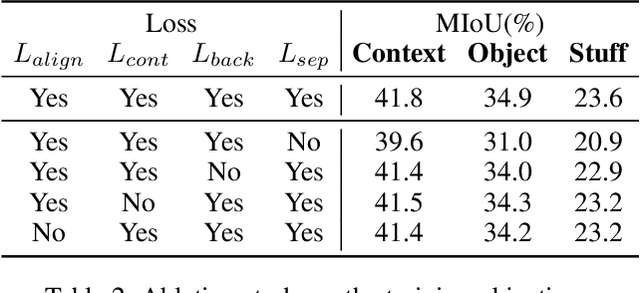
Abstract:Semantic segmentation in open-vocabulary scenarios presents significant challenges due to the wide range and granularity of semantic categories. Existing weakly-supervised methods often rely on category-specific supervision and ill-suited feature construction methods for contrastive learning, leading to semantic misalignment and poor performance. In this work, we propose a novel weakly-supervised approach, SynSeg, to address the challenges. SynSeg performs Multi-Category Contrastive Learning (MCCL) as a stronger training signal with a new feature reconstruction framework named Feature Synergy Structure (FSS). Specifically, MCCL strategy robustly combines both intra- and inter-category alignment and separation in order to make the model learn the knowledge of correlations from different categories within the same image. Moreover, FSS reconstructs discriminative features for contrastive learning through prior fusion and semantic-activation-map enhancement, effectively avoiding the foreground bias introduced by the visual encoder. In general, SynSeg effectively improves the abilities in semantic localization and discrimination under weak supervision. Extensive experiments on benchmarks demonstrate that our method outperforms state-of-the-art (SOTA) performance. For instance, SynSeg achieves higher accuracy than SOTA baselines by 4.5\% on VOC, 8.9\% on Context, 2.6\% on Object and 2.0\% on City.
Towards Mobile Sensing with Event Cameras on High-mobility Resource-constrained Devices: A Survey
Mar 29, 2025Abstract:With the increasing complexity of mobile device applications, these devices are evolving toward high mobility. This shift imposes new demands on mobile sensing, particularly in terms of achieving high accuracy and low latency. Event-based vision has emerged as a disruptive paradigm, offering high temporal resolution, low latency, and energy efficiency, making it well-suited for high-accuracy and low-latency sensing tasks on high-mobility platforms. However, the presence of substantial noisy events, the lack of inherent semantic information, and the large data volume pose significant challenges for event-based data processing on resource-constrained mobile devices. This paper surveys the literature over the period 2014-2024, provides a comprehensive overview of event-based mobile sensing systems, covering fundamental principles, event abstraction methods, algorithmic advancements, hardware and software acceleration strategies. We also discuss key applications of event cameras in mobile sensing, including visual odometry, object tracking, optical flow estimation, and 3D reconstruction, while highlighting the challenges associated with event data processing, sensor fusion, and real-time deployment. Furthermore, we outline future research directions, such as improving event camera hardware with advanced optics, leveraging neuromorphic computing for efficient processing, and integrating bio-inspired algorithms to enhance perception. To support ongoing research, we provide an open-source \textit{Online Sheet} with curated resources and recent developments. We hope this survey serves as a valuable reference, facilitating the adoption of event-based vision across diverse applications.
SURGEON: Memory-Adaptive Fully Test-Time Adaptation via Dynamic Activation Sparsity
Mar 26, 2025



Abstract:Despite the growing integration of deep models into mobile terminals, the accuracy of these models declines significantly due to various deployment interferences. Test-time adaptation (TTA) has emerged to improve the performance of deep models by adapting them to unlabeled target data online. Yet, the significant memory cost, particularly in resource-constrained terminals, impedes the effective deployment of most backward-propagation-based TTA methods. To tackle memory constraints, we introduce SURGEON, a method that substantially reduces memory cost while preserving comparable accuracy improvements during fully test-time adaptation (FTTA) without relying on specific network architectures or modifications to the original training procedure. Specifically, we propose a novel dynamic activation sparsity strategy that directly prunes activations at layer-specific dynamic ratios during adaptation, allowing for flexible control of learning ability and memory cost in a data-sensitive manner. Among this, two metrics, Gradient Importance and Layer Activation Memory, are considered to determine the layer-wise pruning ratios, reflecting accuracy contribution and memory efficiency, respectively. Experimentally, our method surpasses the baselines by not only reducing memory usage but also achieving superior accuracy, delivering SOTA performance across diverse datasets, architectures, and tasks.
Ultra-High-Frequency Harmony: mmWave Radar and Event Camera Orchestrate Accurate Drone Landing
Feb 20, 2025Abstract:For precise, efficient, and safe drone landings, ground platforms should real-time, accurately locate descending drones and guide them to designated spots. While mmWave sensing combined with cameras improves localization accuracy, the lower sampling frequency of traditional frame cameras compared to mmWave radar creates bottlenecks in system throughput. In this work, we replace the traditional frame camera with event camera, a novel sensor that harmonizes in sampling frequency with mmWave radar within the ground platform setup, and introduce mmE-Loc, a high-precision, low-latency ground localization system designed for drone landings. To fully leverage the \textit{temporal consistency} and \textit{spatial complementarity} between these modalities, we propose two innovative modules, \textit{consistency-instructed collaborative tracking} and \textit{graph-informed adaptive joint optimization}, for accurate drone measurement extraction and efficient sensor fusion. Extensive real-world experiments in landing scenarios from a leading drone delivery company demonstrate that mmE-Loc outperforms state-of-the-art methods in both localization accuracy and latency.
 Add to Chrome
Add to Chrome Add to Firefox
Add to Firefox Add to Edge
Add to Edge